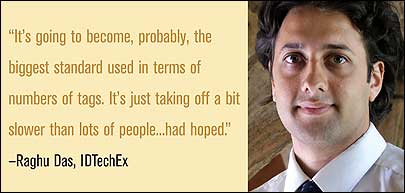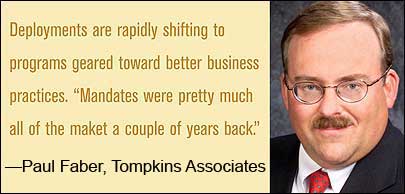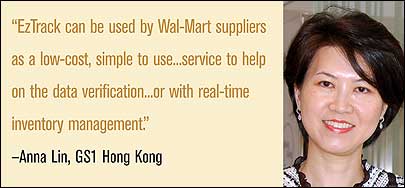A tipping point is the moment of critical mass—the instant when a slow, reversible change becomes irreversible, often with dramatic consequences.
It’s often mentioned in many parts of the RFID industry that Electronic Product Code technology and its accompanying set of standards may be heading toward a tipping point—signifying either a rapid breakthrough into the business mainstream or, alternatively, a quick drop into the great technology dustbin. The big question now looming above RFID vendors, adopters and potential adopters—not to mention EPC commercializer EPCglobal and its parent, supply-chain standards organization GS1—is whether EPC is indeed approaching critical mass. And, if so, when will the inevitable moment arrive, and which path will EPC follow?
|
|
The stakes are high for everyone involved. Broader adoption of EPC and its related standards collection promises to lead to better data sharing within and across industries, creating less operational confusion, greater efficiencies, enhanced visibility, more customer satisfaction and lower technology costs. Early adopters would see their investment in RFID pay off, and potential adopters would know it was time to get off the sidelines or risk being at a competitive disadvantage. For EPCglobal, a tipping point would set the organization on a course toward becoming, perhaps, the RFID industry’s top administrative authority.
When RFID Journal looked at the EPC market last year, there was widespread consensus that the technology had finally reached a high level of maturity, as evinced by multiple pilots conducted worldwide. Twelve months later, we’re seeing solidifying universal and industry-specific standards, innovative support projects, and a batch of new and expanded pilots. But the answer as to when EPC will tip toward the business mainstream—few believe the technology isn’t on a track toward eventual widespread adoption—depends on whom one speaks with, even within EPCglobal.
Chris Adcock, president of Brussels-based EPCglobal, brushes aside the notion that EPC is relentlessly moving toward a single breakout moment. He sees progress coming in stages. “Is there some magical tipping point that’s going to occur in the future?” he asks. “I’m not sure there is, but I think there will be a number of forces that drive companies to consider a range of technologies, of which this will be one.”
David Lyon, EPCglobal business manager for GS1 UK in London, says EPCglobal is pushing EPC ahead by building a sophisticated business and technical support platform. “What’s changing is that we’re realizing our goals from when we started some five years ago,” he says. Pointing to EPCglobal’s work in creating the Gen 2 tag and reader protocol, Lyon says progress is moving steadily forward. “We have one tag that can be read by many readers in many countries that is low-cost and high-performing,” he says. “With the accompanying data exchange between partners giving that [tag] the increased visibility in the supply chain that we’ve been after, we’re realizing our goals.”
Raghu Das, CEO of IDTechEx, a Boston-based RFID and smart-packaging consulting firm, believes EPC’s ultimate destiny is assured. “It’s going to become, probably, the biggest standard used in terms of numbers of tags,” he says. “It’s just taking off a bit slower than lots of people, particularly at EPCglobal, had hoped.”
The Global Standards March
Most parties interested in EPC consider both universal and industry-specific standards to be vital to the technology’s long-term future. From an adopter standpoint—in industries ranging from pharmaceutical distribution to transportation logistics—standardization promises access to RFID’s productivity and efficiency benefits while avoiding some of the biggest drawbacks, such as incompatibility with RFID systems operated by other business partners, the need to support multiple RFID platforms, and devoting scarce resources to a proprietary platform that might eventually fall by the wayside.
Few people are more concerned about RFID standardization than Henri Barthel, coordinator of the Global RFID Interoperability Forum for Standards (GRIFS), a GS1-led project that aims to promote RFID standardization—and EPCglobal standards—worldwide.
Launched at the start of this year, GRIFS was triggered by the observation that RFID standardization has not been consistently well coordinated globally, and that EPCglobal standards hold the key to RFID interoperability. “Standards bodies are not always aware of existing standards and standards under development by other bodies,” Barthel says. “This leads to a lack of interoperability between standards, a duplication of work and, therefore, a complicated environment for the adoption of the technology by users.” Barthel believes that these problems can be solved, or avoided entirely, through better collaboration among standards organizations around the world.
The main goal of GRIFS, Barthel says, is to develop a formal Memorandum of Understanding (MoU) between key global RFID standards institutions and stakeholders, such as RFID vendors, technology researchers and major adopters. “Beyond this MoU, we aim at creating a forum of collaboration where these stakeholders, but also other interested parties, will participate and contribute,” he says. “The forum will develop collaboration activities such as meetings of the MoU members and open conferences, a database compiling all existing RFID standards and those in development, a Web site, newsletters and so on.”
Barthel feels that EPCglobal standards are crucial to global RFID standardization. “Some of the GS1 EPCglobal standards, such as Gen 2, are already today applied by the majority of organizations implementing RFID in supply-chain or item-management applications,” he says. Barthel notes that several other EPCglobal standards—including EPC Information Services (EPCIS), the network infrastructure that enables companies to store data associated with EPCs in secure databases on the Web—currently face no direct competition and will likely be embraced by an overwhelming majority of RFID technology developers and adopters in the years to come.
“The full suite of GS1 EPCglobal standards comprises a unique identification scheme, robust air interfaces, middleware and data-exchange standards,” Barthel says. “They fit very well the need of companies looking at using RFID with their trading partners on a local or a global scale.”
As GRIFS works to promote global RFID standardization, many standards are already falling into place. EPCIS, for example, was formally ratified in 2007. “That was a key element that dropped into place last year,” says Paul Faber, a principal partner at Tompkins Associates, a Raleigh, N.C.-based industrial engineering firm that offers RFID supply-chain consulting services. “The EPCIS standard is the key IT standard for the widespread adoption of information sharing.”
RFID Journal readers seem to agree with this assessment. In a recent survey on the state of EPC adoption, 92 percent of respondents said they believed EPCIS would facilitate business in the global supply chain. And 84 percent agreed that Discovery Services, a specification that will allow companies to search EPC network databases for information, would facilitate business in the global supply chain.
Yet IDTechEx’s Das notes that EPCIS benefits aren’t being felt equally across all RFID applications. “EPCIS probably has greatest applicability in the retail supply chain,” he says. “The business case for RFID in the supply chain for pallets and cases is not very strong.”
This means that retail supply-chain players, many of which are moving toward item-level tagging, may be looking at an EPC tipping point that’s significantly closer than the one envisioned by most nonretail supply-chain observers, though it’s still too soon to set an exact timeline for either area. “It will take a while, I think, before it takes off there [in the nonretail supply chain], although there certainly are a lot of pilots going on,” Das says.
Verticals on the March
Tompkins’ Faber believes that, thanks to a growing confidence in reliable EPCglobal standards, deployments are rapidly shifting from programs based strictly on partner mandates to those geared toward better business practices. “Mandates were pretty much all of the market a couple of years back,” he says.
In fact, contrary to widespread perception, pilot projects typically originate from both the end users and the solution provider community, with GS1 or EPCglobal playing the role of facilitator. “It’s really one of the things that we do best—bringing communities together to understand how this technology can work to improve business processes,” says EPCglobal’s Adcock.
He notes that business partner-driven pilots help EPCglobal better understand how standards can be used to adapt EPC technology to specific vertical industry needs, and to address the barriers that can block businesses from adopting the technology. The pilots are also helping to highlight the EPCglobal network’s strengths and weaknesses, directing developers toward standards and procedures that may need further tweaking.
Adcock points to a pilot launched late last year by DVD distributors and retailers as an example of how the market is helping EPCglobal bring its technology to key vertical industries. During the trial, EPC labels were placed on more than 15 movie titles—some 12,000 new DVDs—issued by studios and distributors including Cinram, Sony Pictures Home Entertainment, Technicolor, Twentieth Century Fox and Warner Home Video. The EPC-labeled DVDs were distributed to several national retail-chain outlets, such as Best Buy and Wal-Mart stores in Minnesota and Oklahoma. “Retailers can use the EPC to ensure that products are kept in stock to meet shopper demand,” Adcock says, “as well as to help shoppers find the right product in the right place inside the store.”
The DVD pilot helped get “the industry players in a particular product category to agree to do things in a standardized way, beyond just the technical standards,” Adcock says. The pilot motivated its participants to align and refine multiple shipping, storage and retail floor practices and technologies—all the way down to the issue of where to place the tags on individual DVD boxes—to allow shipments to move efficiently and effectively through the supply chain. “As the distributor and retail communities come together, they define the requirements for making the technology work,” Adcock says. “Part of this effort turns into the standards, and part of it turns into guidelines…on how to adopt the technology—that’s really how the idea for a pilot is generated.”
Tipping Back
GS1 and EPCglobal face a formidable selling job, however, when dealing with mature businesses that already have entrenched supply-chain practices. Das notes that many established companies and industries are already exchanging information within their own formal and informal communities, “so there is a major effort involved in getting them to move to the EPCglobal network.”
In addition, a number of industry pilots are being conducted independently of GS1 and EPCglobal. “The nature of these pilots is that a lot of them are using EPC tags for closed-loop tracking within some proprietary system,” Faber says. “There’s a lot of that kind of stuff going on.”
Such initiatives pose a potential threat to the long-term strategy carefully cultivated by the standards organizations. “EPCglobal has developed the Gen 2 tag,” Das says, “but to use their code you need to join EPCglobal, pay a license fee and then they manage all the numbers.” A substantial number of businesses acquiring Gen 2 tags elect to adopt another, non-EPC numbering scheme. “That way they don’t have to pay or join EPCglobal,” Das says. “They’ll still be using Gen 2 tags, and getting the benefit of having a fairly good technology and having lots of cheap tags, but they’ll be using their own numbering system, as opposed to using the EPC numbering system.”
Still, Das notes, some organizations see solid value in using the EPC numbering system even for closed-loop applications, which shows that EPCglobal’s influence extends far beyond the businesses that decide to adopt the organization’s entire game plan. Last year, the Florida State Attorney’s 15th Judicial Circuit deployed an EPC-based RFID system to enable it to rapidly locate legal documents pertaining to some 21,000 felony cases.
Dan Zinn, the 15th Judicial Circuit’s CIO, says the office and its system provider, Richardson, Texas-based InnerWireless, selected EPC technology on the basis of its security attributes. “It eliminates the potential for duplicating [tag] numbers, which could be a problem if some odd number walked through the readers,” he says. “By registering a range of numbers and having the readers only reading that range, nothing can come into the system and cause a security problem or a tracking issue.”
Plodding Progress
Despite the growing number of supply-chain pilots, many EPCglobal network observers continue to be concerned about the relatively sparse number of full rollouts. “It would be nice to see more companies go on and do more beyond the trial,” Das says. “We do see quite a few trials, but few businesses are then moving ahead…to major rollouts.” Yet Das cautions that one shouldn’t necessarily leap to the conclusion that businesses are generally displeased with pilot project results. He notes that major EPCIS-based RFID deployments are complex and demanding undertakings “that take time, just due to the scale of what’s involved.” He adds, “The point is, we are still at the very beginning.”
For its part, GS1 is hoping to give the EPCglobal network a big push forward with its new online track-and-trace platform. Launched earlier this year, using EPCglobal standards and services, ezTrack aims to give participating businesses no-fuss access to information about RFID-tagged goods moving through the supply chain. By providing a doorway to data on inventory, progress status and delivery schedules, the platform is intended to help users—particularly small and midsize businesses that lack sophisticated back-end systems—adopt EPC-based RFID tracking with only a minimal financial investment. “It’s an EPC standards-based track-and-trace community service,” says Anna Lin, CEO of GS1 Hong Kong.
Lin notes that the platform should appeal to a wide range of businesses and potential EPCglobal network adopters. “EzTrack can be used in the supply chain by manufacturers, logistics companies and retailers,” she says. But she adds that the technology is just taking its first steps. Lin says that Wal-Mart suppliers in Asia are likely to come onboard in the near future, and that ezTrack should prove appealing to such businesses. Sam’s Club is requiring suppliers to start tagging sellable units by October 2009, and Lin believes that’s where ezTrack’s real value lies. “Sam’s Club has hundreds of suppliers in Asia Pacific,” she says. “EzTrack can be used by Wal-Mart suppliers as a low-cost, simple-to-use sort of plug-and-play service to help on the data verification or with some of the existing modules, like real-time inventory and asset management.”
EPCglobal is also working hard to bring the technology to the forefront—and help companies get out of the EPCglobal network starting gate—through education and technical support. Last November, for example, the organization created a business instruction and support center in Cheshire, England. “The key point of our RFID test center is spurring adoption,” says GS1 UK’s Lyon. “The center provides help to organizations that are investigating RFID, or maybe they’ve gotten themselves into trouble in a particular deployment.”
Lyon notes that other European GS1 groups are busy creating their own centers, focusing on various aspects of RFID research and support. “We’re forming a sort of network so that we can leverage our strengths,” he says. In fact, GS1 organizations worldwide are looking at ways to assist businesses.
Tipping Forward
While optimism is generally high, it’s hard to find anyone—inside or outside EPCglobal—who feels that EPC’s tipping point is imminent. Among industry observers, five years is a time frame that’s often mentioned, although most admit that their prediction is only rough speculation. As Faber notes, “The five-year estimate is kind of the standard timeline when people look at this stuff.”
Meanwhile, the transition from mandates to business-driven pilots is ongoing, although the pace is hardly breathtaking. Of all the forces spurring EPC adoption and bringing the tipping point in sight, competition may ultimately step forward to become the strongest and most critical motivator. “As companies are successful in using this technology to transform their business processes—either by managing their operations more efficiently or effectively, or for the greater satisfaction and benefit of their customers—they will achieve some advantage over their competitors,” Adcock says.
Product authentication, for example, is one EPC application that companies in many industries are already embracing. “That’s in clothing, pharmaceuticals, ink-jet printer heads, electronic components and aerospace,” Faber says.
Actually, many factors—some good, some bad—promise to influence EPC’s rollout during the next five years and beyond. On the positive side, industry players can take heart in faster-than-expected acceptance of item-level tagging among retailers. They can also look forward to additional technology breakthroughs, such as Mojix’s potentially game-changing RFID technology that promises greater coverage and the ability to locate tags in 3-D. Furthermore, new legislation and regulations, in areas such as pharmaceuticals and livestock tracking, could help to propel EPC forward.
On the other hand, there are agents that threaten to slow, if not entirely derail, EPC progress. Many of these perils extend far beyond ordinary technology influences and business dealings. Negative media reports and showboating politicians grandstanding on supposed privacy concerns are always a threat. Economic downturns, wars and terrorist attacks are other wild cards.
In light of all these factors, RFID industry players waiting for EPC to reach its tipping point will likely discover that patience truly is a virtue. Das points to the struggle that bar-code supporters faced in generating widespread acceptance of that technology. “It took about 30 years for bar codes to go from being ‘inventive’ to being on all items,” he says. “It gives you some idea that these things can’t happen within a few years, or even five or six years.”





